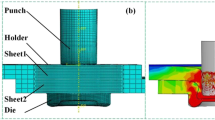Abstract
Clinching is a convenient and efficient cold forming process that can join two sheets without any additional part. This study establishes an intelligent system for optimizing the clinched joint. Firstly, a mathematical model which introduces the ductile damage constraint to prevent cracking during clinching process is proposed. Meanwhile, an optimization methodology and its corresponding computer program are developed by integrated finite element model (FEM) and genetic algorithm (GA) approach. Secondly, Al6061-T4 alloy sheets with a thickness of 1.4mm are used to verify this optimization system. The optimization program automatically acquires the largest axial strength which is approximately equal to 872N. Finally, sensitivity analysis is implemented, in which the influence of geometrical parameters of clinching tools on final joint strength is analyzed. The sensitivity analysis indicates the main parameters to influence joint strength, which is essential from an industrial point of view.
Similar content being viewed by others
References
VARIS J P, LEPISTö J. A simple testing-based procedure and simulation of the clinching process using finite element analysis for establishing clinching parameters [J]. Thin-Walled Structures, 2003, 41(8): 691–709.
HAMEL V, ROELANDT J M, GACEL J N, et al. Finite element modeling of clinch forming with automatic remeshing [J]. Computers and Structures, 2000, 77(2): 185–200.
COPPIETERS S, LAVA P, BAES S, et al. Analytical method to predict the pull-out strength of clinched connections [J]. Thin-Walled Structures, 2012, 52(1): 42–52.
COPPIETERS S, LAVA P, HECKE R V, et al. Numerical and experimental study of the multi-axial quasistatic strength of clinched connections [J]. International Journal of Material Forming, 2012, 6(4): 437–451.
LAMBIASE F, ILIO A D. Damage analysis in mechanical clinching: Experimental and numerical study [J]. Journal of Materials Processing Technology, 2016, 230: 109–120.
COPPIETERS S, COOREMAN S, LAVA P, et al. Reproducing the experimental pull-out and shear strength of clinched sheet metal connections using FEA [J]. International Journal of Material Forming, 2010, 4(4): 429–440.
OUDJENE M, BEN-AYED L. On the parametrical study of clinch joining of metallic sheets using the Taguchi method [J]. Engineering Structures, 2008, 30(6): 1782–1788.
LAMBIASE F, ILIO A D. Optimization of the clinching tools by means of integrated FE modeling and artificial intelligence techniques [J]. Procedia CIRP, 2013, 12: 163–168.
ROUX E, BOUCHARD P O. Kriging metamodel global optimization of clinching joining processes accounting for ductile damage [J]. Journal of Materials Processing Technology, 2013, 213(7): 1038–1047.
SUN X, KHALEEL M A. Performance optimization of self-piercing rivets through analytical rivet strength estimation [J]. Journal of Manufacturing Processes, 2005, 7(1): 83–93.
OUDJENE M, BEN-AYED L, DELAMéZIèRE A, et al. Shape optimization of clinching tools using the response surface methodology with moving least-square approximation [J]. Journal of Materials Processing Technology, 2009, 209(1): 289–296.
LEBAAL N, OUDJENE M, ROTH S. The optimal design of sheet metal forming processes: Application to the clinching of thin sheets [J]. International Journal of Computer Applications in Technology, 2012, 43(2): 110–116.
LEE C J, KIM J Y, LEE S K, et al. Design of mechanical clinching tools for joining of aluminium alloy sheets [J]. Materials and Design, 2010, 31(4): 1854–1861.
LEE C J, KIM J Y, LEE S K, et al. Parametric study on mechanical clinching process for joining aluminum alloy and high-strength steel sheets [J]. Journal of Mechanical Science and Technology, 2010, 24(1): 123–126.
GERSTMANN T, AWISZUS B. Recent developments in flat-clinching [J]. Computational Materials Science, 2014, 81(2): 39–44.
HAMBLI R, RESZKA M. Fracture criteria identification using an inverse technique method and blanking experiment [J]. International Journal of Mechanical Sciences, 2002, 44(7): 1349–1361.
CHEN C, ZHAO S D, HAN X L, et al. Optimization of a reshaping rivet to reduce the protrusion height and increase the strength of clinched joints [J]. Journal of Materials Processing Technology, 2016, 234: 1–9.
LEE C J, LEE J M, RYU H Y, et al. Design of hole-clinching process for joining of dissimilar materials Al6061-T4 alloy with DP780 steel, hot-pressed 22MnB5 steel, and carbon fiber reinforced plastic [J]. Journal of Materials Processing Technology, 2014, 214(10): 2169–2178.
Author information
Authors and Affiliations
Corresponding author
Additional information
Foundation item: the Fundamental Research Funds for the Central Universities of China (No. CDJZR14130006)
Rights and permissions
About this article
Cite this article
Wang, M., Xiao, G., Wang, J. et al. Optimization of Clinching Tools by Integrated Finite Element Model and Genetic Algorithm Approach. J. Shanghai Jiaotong Univ. (Sci.) 24, 262–272 (2019). https://doi.org/10.1007/s12204-018-1995-9
Received:
Published:
Issue Date:
DOI: https://doi.org/10.1007/s12204-018-1995-9



